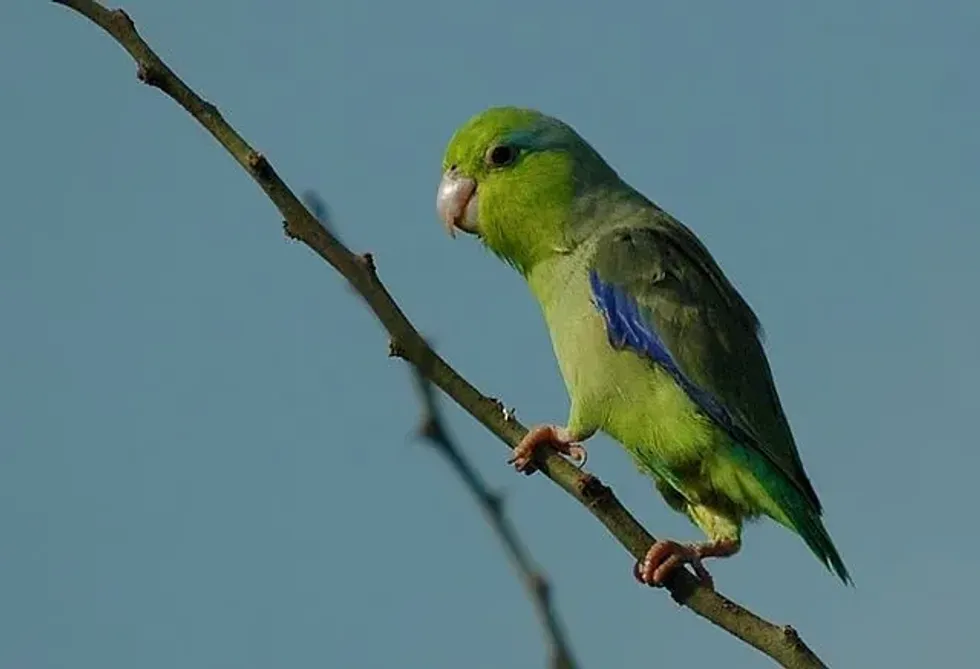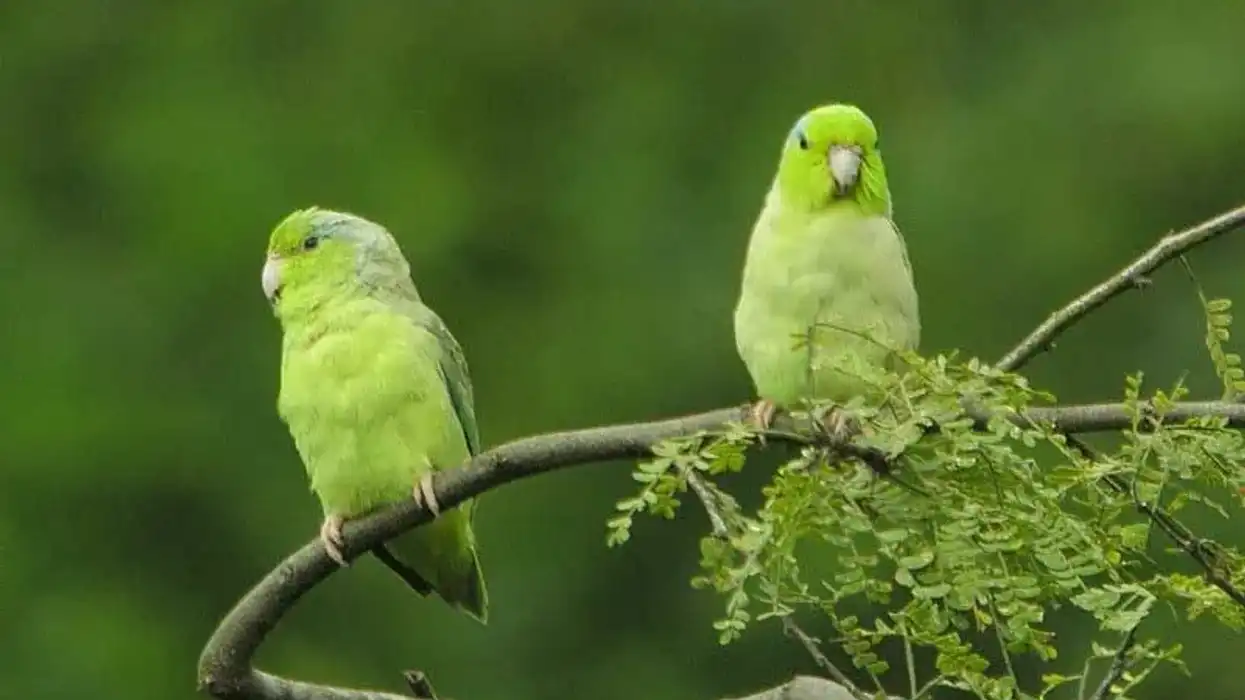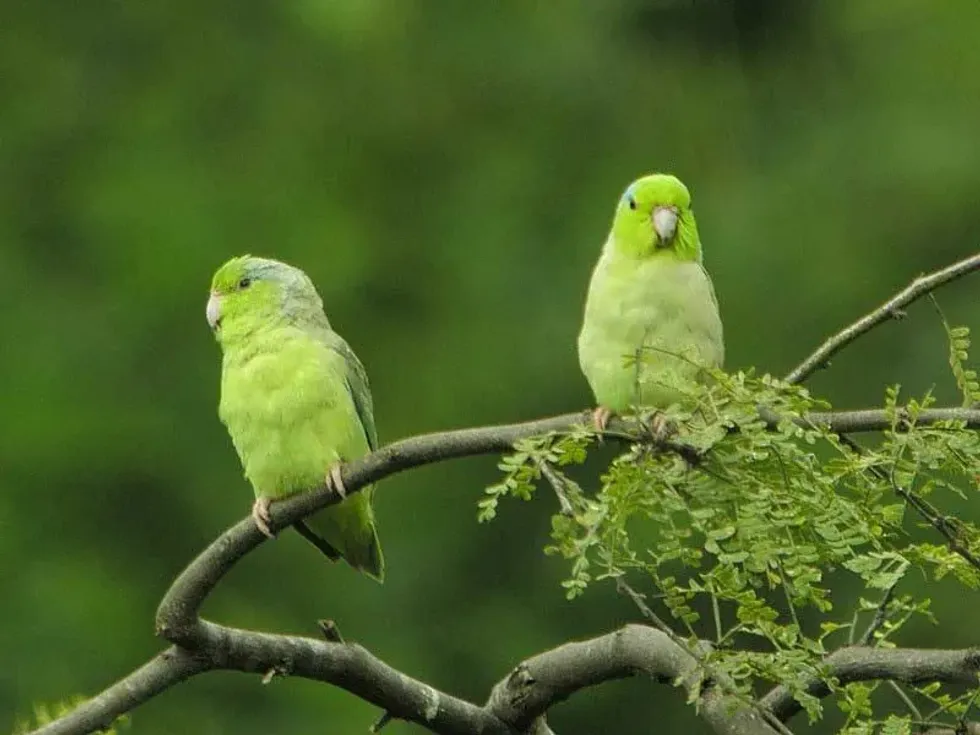Fun Pacific Parrotlet Facts For Kids

Content
- What type of animal is a Pacific parrotlet?
- What class of animal does a Pacific parrotlet belong to?
- How many Pacific parrotlets are there in the world?
- Where does a Pacific parrotlet live?
- What is a Pacific parrotlet's habitat?
- Who do Pacific parrotlets live with?
- How long does a Pacific parrotlet live?
- How do they reproduce?
- What is their conservation status?
- What do Pacific parrotlets look like?
- How cute are they?
- How do they communicate?
- How big is a Pacific parrotlet?
- How fast can a Pacific parrotlet fly?
- How much does a Pacific parrotlet weigh?
- What are the male and female names of the species?
- What would you call a baby Pacific parrotlet?
- What do they eat?
- Are they aggressive?
- Would they make a good pet?
- Did you know...
- How strong is a Pacific parrotlet?
- What bird are Pacific parrotlets said to be closely related to?
The Pacific parrotlet (Forpus coelestis) bird belongs to the parrot family. They originated in South America, and are found in western Ecuador, northwestern Peru.
Their feathers are green-colored, and they are really beautiful. They are often kept as a pet in a cage by people, though they require a lot of attention, Pacific parrotlet taming, and care, so you should be ready to give three to four hours on the daily to them.
This bird is one of the best pets ever, and in the wild, they live in woodlands, gardens, parks, and shrubby clearings. The Pacific parrotlet care is very elaborate.
Here, we have many amazing and interesting facts about the Pacific parrotlet species that you will enjoy. Let's take a look at these facts and information, and if you enjoy these then, do read our Brewer's blackbird facts and Tennessee warbler facts for more.
Pacific Parrotlet Interesting Facts
What type of animal is a Pacific parrotlet?
Pacific parrotlet (Forpus coelestis) is a type of bird.
What class of animal does a Pacific parrotlet belong to?
Pacific parrotlet belongs to the class Aves. This bird belongs to the parrotlet species.
How many Pacific parrotlets are there in the world?
The total number of the Pacific parrotlet bird is not available. This bird is a Least Concern species, and their population size is stable. So we can assume that there is a large number of them alive in the world.
Where does a Pacific parrotlet live?
The Pacific parrotlet is found living in woodlands, gardens, parks, and shrubby clearings. Their diet contains fruits or seeds, and these food items are easily available in these locations.
What is a Pacific parrotlet's habitat?
Pacific parrotlets are found in gardens, parks, and woodlands. They originated in South America and are found in western Ecuador and northwestern Peru. They are also found in southwestern Colombia and in Rio Mataje. They prefer a habitat that has plenty of food and can get them a proper diet.
Who do Pacific parrotlets live with?
In the wild, Pacific parrotlets are found in large flocks containing 40-50 birds. They are very social animals. But in captivity, it's the exact opposite. They become more aggressive towards other birds. It is advised to keep them in a separate cage.
How long does a Pacific parrotlet live?
Pacific parrotlet lifespan depends on where they live. They live for about 20 years.
In captivity, they are recorded to live up to 25-30 years. It depends on how you take care of them. In the wild, they only live for 10-15 years, and the main reason behind their short lifespan is the unavailability of a proper diet, danger from predators, and lack of medical care.
How do they reproduce?
These birds are really good breeders. They nest in cavities of trees or fence posts or sometimes in abandoned nests of other birds.
In captivity, they can be bred easily; they require a cage that is a minimum of 6 x 6 x 6 in (15 x 15 x 15 cm) size. Most breeders often use a cage that is about 18 x 24 x 24 in (46 x 61 x 61 cm).
They often become foster parents for eggs of other species and raise their chicks.
They lay around four to six eggs per clutch, which incubates for 18 days. Parents take care of young chicks and feed them for about four to five weeks. After that, they are ready to leave the nest. They take care of chicks for several weeks, even after they leave the nest.
What is their conservation status?
The conservation status of the Pacific parrotlet birds is Least Concern. Their population size is unknown, though it is estimated that they have a stable population and do not face any threats that might endanger their population. These birds are really loved by humans and are often kept as a pet by them.
Pacific Parrotlet Fun Facts
What do Pacific parrotlets look like?
The Pacific parrotlet that lives in the wild has a green-colored body and a dusky gray cast on its body. It has a cute pink-colored beak, and its legs and feet are also pink.
It has a bright green mask on its face.
Their sex is easy to determine, as you can tell only by looking at them. Males have sporty blue color on the wings, which can vary from bright cobalt blue to dull lavender shade of blue, and they also have blue-colored steaks behind their eyes, and they also have blue rumps.
Females do not possess blue color on their wings, but they also have blue steaks and rumps like male Pacific parrotlet. Pacific parrotlets, in general, have a green color, but sometimes they have different colors like blue, lutino, albino, dilute green, fallow, American yellow, European yellow, pied, dark factor, pastel, and cinnamon.

How cute are they?
Pacific parrotlets are really cute and affectionate little birds. These pets have features that are similar to parrots, and they make them look like miniature parrots.
This parrotlet species is called a 'pocket parrot' for its small size. But unlike their size, they have a personality of a big bird. You must have a look at a Pacific blue parrotlet and let us know how cute they are!
How do they communicate?
These pets are intelligent and smart little birds that use high-pitched and rapid calls to communicate. In flocks, they produce constant chatters.
During the breeding season, males sing soft and pleasant songs. As they belong to the family of parrots, they can learn to talk or mimic your words on their own and can repeat whole sentences after you but are not very clear. However, they are not very loud.
How big is a Pacific parrotlet?
The Pacific parrotlet grows about 4.3–5.5 in (11–14 cm) in length. They are little birds that look like small parrots, so they are called pocket parrots. They are often kept as a pet due to their small size and feisty personalities.
How fast can a Pacific parrotlet fly?
The speed of a Pacific parrotlet has not been measured though they are active birds in the wild that can fly for many hours every day. Their owners should know that they require a lot of exercise in captivity, almost the same as they would get in the wild as they are really active.
How much does a Pacific parrotlet weigh?
The Pacific parrotlet (Forpus coelestis) weighs around only 0.9-1.1 oz (26-32 g). They are very light and small, but their personality is like a bigger bird.
What are the male and female names of the species?
The male and the female species do not have any separate names. However, they are sexually dimorphic birds, which means that you can identify a male or female just by looking at them.
Males have blue on their wings, and they also have blue-colored steaks behind the eyes and blue rumps, while females lack the sporty blue color on their wings, although they also have blue rumps and steaks behind their eyes.
What would you call a baby Pacific parrotlet?
Pacific parrotlet babies are called chicks. Parents are very protective of their chicks and eggs. Pacific parrotlets lay around four to six eggs per clutch during the breeding season and are really good breeders. They take care of abandoned chicks or eggs of other parrotlet species.
What do they eat?
Pacific parrotlets feed on fruits and vegetables, seeds, bird pellets. Their diet mainly consists of good quality bird pellets and is given bird-safe fruits and vegetables and hard-boiled eggs to fulfill the protein requirement for their growth. Pacific parrotlet diet includes apples, bananas, berries, and green leaves like spinach and bean greens. They also like being hand-fed.
Are they aggressive?
Pacific parrotlets that live in the wild have every social and friendly personality. They live in large flocks containing 40-50 birds. Their flocks can sometimes contain up to 100 birds.
But, those who live in a cage are the exact opposite. They become aggressive around other parrot species. Even though they have a small body, their personality resembles a big bird, and due to this reason, they often pick a fight with big parrots.
Would they make a good pet?
Pacific parrotlets are extremely cute, affectionate, and social pet birds. They get along with humans and other Pacific parrotlets like Mexican parrotlet, spectacled parrotlet, green-rumped parrotlet, or blue-winged parrotlet.
They are very active and play a lot with humans. If you fail to provide them toys to play with, they will take your things and play with them.
Pacific parrotlets need a lot of attention, so you should keep in mind that if you want to adopt them, you should be able to give three to four hours daily to them.
As they belong to the parrot family, they can also learn to talk, but you need to be patient enough to teach them how to talk. They are known to learn new things quickly and complete difficult tasks.
They also require exercises and training. They can adapt destructive behavior when bored and might start to nip people, bite off furniture, so proper training and daily interaction are required to keep them contained.
Also, you should give them training regarding how far they should roam in your house, as they are small birds and often hop on the floor or behind furniture, which might cause accidents.
Sometimes, this bird might get too excited and bite its own wings – watch out for this!
Pacific parrotlet cost is around $200-400.
Did you know...
Pacific parrotlet colors change according to their mutations. Pacific parrotlet mutations can cause their feathers to change colors from green to blue, lutino, albino, dilute green, fallow, American yellow, European yellow, pied, dark factor, pastel, and cinnamon.
Pacific parrotlets are a parrotlet species that belong to the parrot family. They are really cute, affectionate, and intelligent pet birds who get along with humans, but their behavior depends on how you take care of them.
They develop destructive behavior when they become bored and might even bite their own wings if they get less attention from their owner or do not get enough exercise.
Pacific parrotlets have a great lifespan and can live up to 25 or even 30 years in captivity. A Pacific parrotlet cage size should be around 18 x 24 x 24 in (46 x 61 x 61 cm) so that they can easily mate during the breeding season. They require a large cage in order to breed easily.
Green Pacific parrotlet price is around $200-400. Pacific parrotlet parrots are available in pet stores, and you can adopt one easily. Pacific parrotlet talking ability is really good as they are a parrot species. They also like to be hand-fed.
Yellow-faced parrotlet is also found in Northwestern Peru. Their yellow face distinguishes them from Pacific parrotlets.
Pacific parrotlet scientific name is Forpus coelestis. It is a really good pet bird, and they usually eat vegetables and seeds. They like to be held by their favorite humans and often ride their shoulder or head and sometimes rest in the chest pocket of their owner.
Males are thought to be better pets than females as they are more playful and talk more than females. They are also less nippy than females.
When their parent human creates a really strong bond with them, they bring out their cuddly personality. These small birds are very cuddly and affectionate and will cuddle a lot with their pet parent once a strong bond has been formed.
According to experts, two Pacific parrotlets should not be kept together because of their aggressive nature. They often fight with each other, though you can prevent this from happening by housing them in the early stages of their life. This might create a strong bond between them.
How strong is a Pacific parrotlet?
An adult Pacific parrotlet might look cute and small, but they have a strong-curved beak. Their bite is very painful and harsh and can sometimes lead to bleeding.
They start to bite after the weaning period and should be taught not to bite anyone. They might bite their owners out of anger or jealousy if they do not pay attention to them.
What bird are Pacific parrotlets said to be closely related to?
Pacific parrotlets are closely related to Amazon parrots. As they belong to the parrot species, they can talk or mimic the words of their owners. Like Amazon parrots, they also have green-colored feathers. Even though they are much smaller than Amazon parrots, they have the personality of the big bird. They are affectionate, and feisty!
Here at Kidadl, we have carefully created lots of interesting family-friendly animal facts for everyone to discover! For more relatable content, check out these Senegal parrot facts and yellow warbler facts pages.
You can even occupy yourself at home by coloring in one of our free printable Pacific parrotlet coloring pages.
We Want Your Photos!
More for You
See All
Bachelor of Commerce specializing in Accounting and Finance, Master of Business Administration

Divya RaghavBachelor of Commerce specializing in Accounting and Finance, Master of Business Administration
With a diverse range of experience in finance, administration, and operations, Divya is a diligent worker known for her attention to detail. Born and raised in Bangalore, she completed her Bachelor's in Commerce from Christ University and is now pursuing an MBA at Narsee Monjee Institute of Management Studies, Bangalore. Along with her professional pursuits, Divya has a passion for baking, dancing, and writing content. She is also an avid animal lover who dedicates her time to volunteering for animal welfare causes.
Bachelor of Commerce specializing in Marketing and HR

Pradhanya RaoBachelor of Commerce specializing in Marketing and HR
With a Bachelor’s degree in Commerce from Christ University, Bangalore, Pradhanya's passion for the English language and literature led her to explore the field of content writing, where she has gained extensive experience in writing, reviewing, editing, and fact-checking. She has also earned certifications in Google Ads Search, Google Ads Display, and Social Media Marketing, showcasing her proficiency in digital marketing.
Disclaimer
1) Kidadl is independent and to make our service free to you the reader we are supported by advertising. We hope you love our recommendations for products and services! What we suggest is selected independently by the Kidadl team. If you purchase using the Buy Now button we may earn a small commission. This does not influence our choices. Prices are correct and items are available at the time the article was published but we cannot guarantee that on the time of reading. Please note that Kidadl is a participant in the Amazon Services LLC Associates Program, an affiliate advertising program designed to provide a means for sites to earn advertising fees by advertising and linking to Amazon. We also link to other websites, but are not responsible for their content.
2) At Kidadl, we strive to recommend the very best activities and events. We will always aim to give you accurate information at the date of publication - however, information does change, so it’s important you do your own research, double-check and make the decision that is right for your family. We recognise that not all activities and ideas are appropriate for all children and families or in all circumstances. Our recommended activities are based on age but these are a guide. We recommend that these ideas are used as inspiration, that ideas are undertaken with appropriate adult supervision, and that each adult uses their own discretion and knowledge of their children to consider the safety and suitability. Kidadl cannot accept liability for the execution of these ideas, and parental supervision is advised at all times, as safety is paramount. Anyone using the information provided by Kidadl does so at their own risk and we can not accept liability if things go wrong.
3) Because we are an educational resource, we have quotes and facts about a range of historical and modern figures. We do not endorse the actions of or rhetoric of all the people included in these collections, but we think they are important for growing minds to learn about under the guidance of parents or guardians.







